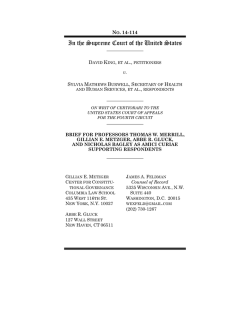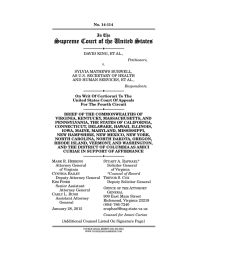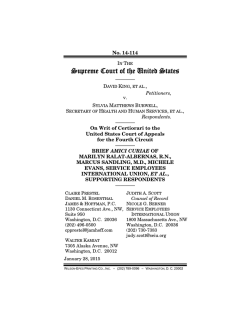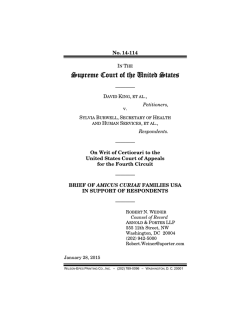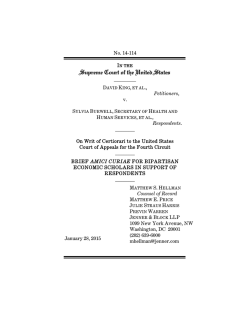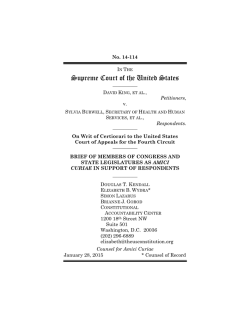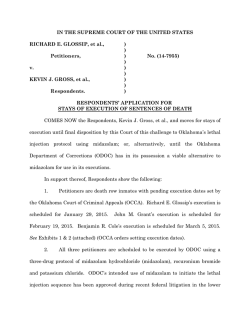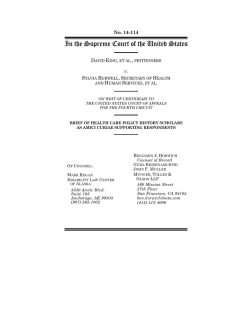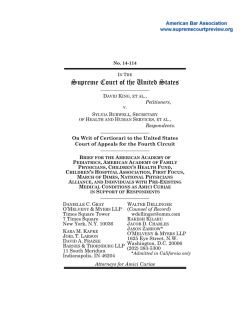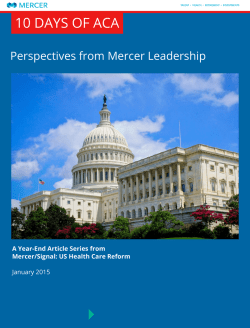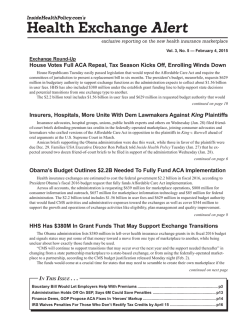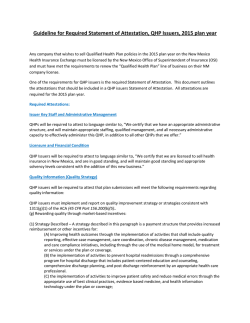
Supreme Court of the United States
No. 14-114 Supreme Court of the United States IN THE DAVID KING, et al., Petitioners, v. SYLVIA MATTHEWS BURWELL, AS U.S. SECRETARY OF HEALTH AND HUMAN SERVICES, et al., Respondents. On Writ of Certiorari to the United States Court of Appeals for the Fourth Circuit BRIEF AMICUS CURIAE OF THE NATIONAL EDUCATION ASSOCIATION IN SUPPORT OF RESPONDENTS ALICE O’BRIEN (Counsel of Record) JASON WALTA ERIC HARRINGTON LISA POWELL MISCHA BAUERMEISTER National Education Association 1201 16th Street, N.W. Washington, DC 20036 (202) 822-7035 Peake DeLancey Printers, LLC - (301) 341-4600 - Cheverly MD i TABLE OF CONTENTS Page TABLE OF AUTHORITIES.................................. iii INTEREST OF AMICUS CURIAE...................... 1 INTRODUCTION AND SUMMARY ................... 2 ARGUMENT .......................................................... 4 I. THE GOVERNMENT’S CONSTRUCTION OF § 36B IS CORRECT. .................................. 4 A. The plain text of the ACA supports the Government’s reading and forecloses the Petitioners’........................ 4 B. The Government’s reading is also the only one that gives effect to the whole ACA, including its core provisions. ......... 7 C. Petitioners’ reading would mean that Congress used a novel tool to induce States to act and that Congress did so surreptitiously................................. 12 D. The Court should reject Petitioners’ reading of § 36B to avoid the serious constitutional questions it raises. ........... 17 1. The Court should not read the ACA tax credits provision to raise serious questions under the AntiCommandeering principle.................. 17 2. The Court should not read the ACA to undermine the principle of equal sovereignty among the States. ........... 21 ii TABLE OF CONTENTS—Continued Page II. PETITIONERS’ READING WOULD HARM FAMILIES AND CHILDREN. ........................ 24 A. Because of the tax credits, millions of working Americans are getting covered, and becoming healthier and more financially secure....................................... 25 B. Petitioners’ reading would harm children and lead to adverse educational outcomes............................... 28 CONCLUSION ....................................................... 30 iii TABLE OF AUTHORITIES CASES: Page Atl. Cleaners & Dyers, Inc. v. United States, 286 U.S. 427 (1932) ........................................ 7 Bond v. United States, 131 S. Ct. 2355 (2011) 18 Brushaber v. Union Pac. R.R. Co., 240 U.S. 1 (1916) ............................................ 24 Church of Scientology v. IRS, 484 U.S. 9 (1987) ............................................ 17 Coll. Sav. Bank v. Fla. Prepaid Postsecondary Educ. Expense Bd., 527 U.S. 666 (1999) ........................................ 20 EPA v. EME Homer City Generation, L.P., 134 S. Ct. 1584 (2014) .................................... 12 Garcia v. San Antonio Metro. Transit Auth., 469 U.S. 528 (1985)............................................ 23 Gonzalez v. United States, 553 U.S. 424 (2008) ........................................ 17 Gregory v. Ashcroft, 501 U.S. 452 (1991) ....... 22 Halbig v. Burwell, 758 F.3d 390 (D.C. Cir. 2014), reh’g en banc granted, judgment vacated, No. 14-5018, 2014 WL 4627181 (D.C. Cir. Sept. 4, 2014) ........... 13 Hodel v. Va. Surface Mining & Reclamation Ass’n, Inc., 452 U.S. 264 (1981) ................... 15 King v. Burwell, 759 F.3d 358 (4th Cir. 2014), cert. granted, 135 S. Ct. 475 (2014) ............. 2, 13 Nat’l Fed’n of Indep. Bus. v. Sebelius, 132 S. Ct. 2566 (2012)............ 2, 15, 17, 18, 19, 20, 21 New York v. United States, 505 U.S. 144 (1992)............................................ 17, 19 iv TABLE OF AUTHORITIES—Continued Page Nw. Austin Mun. Util. Dist. No. One v. Holder, 557 U.S. 193 (2009)........................ 21, 22, 23 Pennhurst State Sch. & Hosp. v. Halderman, 451 U.S. 1 (1981) ................................................ 20 Printz v. United States, 521 U.S. 898 (1997) . 17, 24 Sale v. Haitian Ctrs. Council, Inc., 509 U.S. 155 (1993) ........................................ 16 Shelby County v. Holder, 133 S. Ct. 2612 (2013).................................. 17, 21, 23 South Carolina v. Baker, 485 U.S. 505 (1988) . 23, 24 South Carolina v. Katzenbach, 383 U.S. 301 (1966) ........................................ 22 South Dakota v. Dole, 483 U.S. 203 (1987)..... 21 Stenberg v. Carhart, 530 U.S. 914 (2000) ....... 6 Steward Machine Co. v. Davis, 301 U.S. 548 (1937) ........................................ 15 United States v. Ptasynski, 462 U.S. 74 (1983) .......................................... 24 United States v. Windsor, 133 S. Ct. 2675 (2013) .................................... 16 Whitman v. Am. Trucking Ass’ns, Inc., 531 U.S. 457 (2001) ........................................ 12 STATUTES, CONSTITUTIONS AND REGULATIONS 26 U.S.C. § 36B................................................... 2, 3, 25 26 U.S.C. § 36B(b)(2)(A) .................................. 5 26 U.S.C. § 36B(c)(2)(A)(i) .............................. 5 26 U.S.C. § 36B(f) .............................................. 11 v TABLE OF AUTHORITIES—Continued 42 U.S.C. § 300gg-91(d)(21).............................. 42 U.S.C. § 1320b-23(a)..................................... 42 U.S.C. § 1320b-23(b)..................................... 42 U.S.C. § 1396a(gg)(1) ................................... 42 U.S.C. § 1396w-3(a) ...................................... 42 U.S.C. § 1396w-3(b)(1)(B)........................... 42 U.S.C. § 1396w-3(b)(1)(C)........................... 42 U.S.C. § 1396w-3(b)(1)(D)........................... 42 U.S.C. § 1396w-3(b)(2)................................. 42 U.S.C. § 1396w-3(b)(4)................................. 42 U.S.C. § 1397ee(d)(3)(B) ............................. 42 U.S.C. § 1397ee(d)(3)(C) ............................. 42 U.S.C. § 18031 ............................................... 42 U.S.C. § 18031(b)(1)..................................... 42 U.S.C. § 18031(d)(1)..................................... 42 U.S.C. § 18031(d)(4)(G)............................... 42 U.S.C. § 18031(d)(4)(I)(i)-(ii)...................... 42 U.S.C. § 18032(f)(1)(A)(ii)........................... 42 U.S.C. § 18041 ............................................... 42 U.S.C. § 18041(c) .......................................... U.S. Const. amend. X ........................................ U.S. Const., art. I, § 8, cl. 1 ............................... 26 C.F.R. § 1.36B-1(k)........................................ 26 C.F.R. § 1.36B-2 ............................................. 45 C.F.R. § 155.20............................................... Page 5 11 11 8 10 9, 10 9, 10 9 9 9, 10 8, 9 9 2 5 5 11 11 7 2, 6 6 18 19, 24 3 3 3 vi TABLE OF AUTHORITIES—Continued Page LEGISLATIVE MATERIALS 77 Fed. Reg. 30,1377, 30,3778 (May 23, 2012)... Pub. L. No. 109–73, 119 Stat 2016 (2005)........ Pub. L. No. 107–134, 115 Stat 2427 (2005)...... Pub. L. No. 109–135, 119 Stat 2577 (2005)...... OTHER AUTHORITIES Am. Coll. of Physicians-Am. Soc’y of Internal Medicine, No Health Insurance? It’s Enough to Make You Sick: Scientific Research Linking the Lack of Health Coverage to Poor Health 8-10, 18 (1999), available at http://www.acponline.org/ acp_policy/policies/no_health_insurance _scientific_research_linking_lack_of_ health_coverage_to_poor_health_1999.pdf... Black’s Law Dictionary 1570 (9th ed. 2009) .. Charles E. Basch, Healthier Students Are Better Learners: A Missing Link in School Reforms to Close the Achievement Gap (Mar. 2010), available at http://www. equitycampaign.org/i/a/document/12557 _EquityMattersVol6_Web03082010.pdf....... Christopher B. Forrest et al., School Outcomes of Children With Special Health Care Needs, 128 PEDIATRICS 303 (Aug. 2011) ..................................................... Denise M. Seabert, Academic Achievement and Health, in ENCYCLOPEDIA OF SCHOOL HEALTH 7 (David C. Wiley & Amy C. Cory eds., 2013)....................................................... 3 16 16 16 29 6 29 29 28 vii TABLE OF AUTHORITIES—Continued Page Jonathan H. Adler & Michael F. Cannon, Taxation Without Representation: The Illegal IRS Rule To Expand Tax Credits Under the PPACA, 23 Health Matrix 119 (2013) ....................................................... 14 Larry Levitt et al., How Much Financial Assistance Are People Receiving Under the Affordable Care Act? (Mar. 2014) ......... 26 Linda J. Blumberg et al., Characteristics of Those Affected by a Supreme Court Finding for the Plaintiff in King v. Burwell (Jan. 2015), available at http://www.urban.org/UploadedPDF/ 2000078-Characteristics-of-ThoseAffected-by-King-v-Burwell.pdf. .................. 27, 28 Lorraine V. Klerman, School Absence— A Health Perspective, 35 PEDIATRIC CLINICS OF N. AM. 1254 (1988) .................................... 29 Megan L. Rickard et al., School Superintendents’ Perceptions of Schools Assisting Students in Obtaining Public Health Insurance, 81 J. OF SCH. HEALTH 756 (Dec. 2011) .............................................. 30 Nicholas Zill, Child Health and School Readiness: Background Paper on a National Educational Goal (Oct. 1990), available at http://files.eric.ed.gov/fulltext/ ED415991.pdf. ................................................ 29 Ryan Yeung et al., Can Health Insurance Reduce School Absenteeism?, 43 EDUC. & URBAN SOC’Y 696 (2011) ................................. 30 viii TABLE OF AUTHORITIES—Continued Page Sara R. Collins et al., The Rise in Health Care Coverage and Affordability Since Health Reform Took Effect (Jan. 2015) (estimating enrollment through the 2015 enrollment period), available at http:// www.commonwealthfund.org/~/media/ files/publications/issue-brief/2015/jan/ 1800_collins_biennial_survey_brief.pdf ... 25, 26, 27 U.S. Dep’t of Health & Human Servs., Health “Insurance Marketplace: Summary Enrollment Report for the Initial Annual Open Enrollment Period (May 1, 2014), available at http://aspe.hhs.gov/health/ reports/2014/MarketPlaceEnrollment/ Apr2014/ib_2014Apr_enrollment.pdf. ......... 26 1 INTEREST OF AMICUS CURIAE This brief is submitted with the consent of the parties on behalf of the National Education Association (“NEA”) as amicus curiae in support of the Government Respondents.1 NEA is a nationwide employee organization with nearly three million members, the vast majority of whom serve as educators and education support professionals in our nation’s public schools, colleges, and universities. NEA has a strong interest in ensuring that its members and the children they educate have access to affordable health care. Prior to the enactment of the Patient Protection and Affordable Care Act (“ACA”), many Americans, including many NEA members and many of our students’ families, lacked access to affordable health care. That is changing. The ACA has shrunk the ranks of the uninsured, increased access to needed health care, and improved the financial situation of millions of American families by making access to health insurance affordable by way of the tax credits challenged in this case. Petitioners’ theory in this case has troubling ramifications for NEA’s members and our nation’s school systems as well. The federal government has an important role in funding school systems nationwide to provide greater equity and adequacy of educational opportunity for all. See NEA Resolution A-16, Federal Financial Support for Education. Under Petitioners’ view, Congress 1 Letters of consent from all parties are on file with the Clerk. No counsel for a party authored this brief in whole or in part, and no person or entity other than amicus curiae made a monetary contribution to the preparation or submission of the brief. 2 can attempt to induce states to adopt particular policies by creating a tax system that discriminates against Americans who live in States that do not adopt preferred federal policies. If adopted, Petitioners’ view would mark a mode of Congressional policymaking that is novel and creates serious federalism problems. NEA has grave concerns about the consequences for federal education policy should the Court authorize such a discriminatory and punitive scheme. INTRODUCTION AND SUMMARY Congress passed the ACA to “increase the number of Americans covered by health insurance and decrease the cost of health care.” Nat’l Fed’n of Indep. Bus. v. Sebelius (“NFIB”), 132 S. Ct. 2566, 2580 (2012). Before the ACA’s passage, many Americans who did not receive employer-based health coverage were unable or could not afford to purchase insurance. To make affordable insurance plans available to those Americans, the ACA provides for the establishment of “Exchanges,” through which individuals can purchase competitively-priced health insurance. See 42 U.S.C. §§ 18031, 18041. It also provides federal tax credits to millions of low- and middle-income Americans to offset all or part of the cost of insurance policies purchased on the Exchanges. See 26 U.S.C. § 36B. “The Exchanges facilitate this process by advancing an individual’s eligible tax credit dollars directly to health insurance providers as a means of reducing the upfront cost of plans to consumers.” King v. Burwell, 759 F.3d 358, 364 (4th Cir. 2014), cert. granted, 135 S. Ct. 475 (2014). The Internal Revenue Service (“IRS”) has promulgated regulations making clear that these premium 3 tax credits are available to qualifying individuals who purchase health insurance on any of the Exchanges, whether state-run or federally-facilitated. See 26 C.F.R. § 1.36B–1(k); Health Insurance Premium Tax Credit, 77 Fed. Reg. 30,377, 30,378 (May 23, 2012) (collectively the “IRS Rule”). The IRS Rule provides that the credits shall be available to anyone “enrolled in one or more qualified health plans through an Exchange,” 26 C.F.R. § 1.36B–2, and then adopts by cross-reference the Health and Human Services “HHS” definition of “Exchange” that includes any Exchange, “regardless of whether the Exchange is established and operated by a State . . . or by HHS,” 45 C.F.R. § 155.20. The Petitioners’ have challenged the IRS rule, arguing that it violates the plain text of 26 U.S.C. § 36B, the tax credits provision of the ACA. They argue that the premium assistance provided for by the tax credits is available only to those who purchase coverage from state-run Exchanges and not those who purchase coverage through federally-facilitated Exchanges. The Petitioners are wrong. The ACA makes clear that an “Exchange established by the State” is a term of art, which includes all Exchanges, whether state-run or facilitated by the Federal Government. The Petitioners’ contrary construction makes little sense when the overall statute is considered, and would in fact undermine key provisions of the ACA, including provisions designed to protect children. It would mean that the federally-facilitated Exchanges have no one to sell insurance to, that States with federally-facilitated Exchanges can never make eligibility changes to their Medicaid programs, and that several of the ACA’s provisions designed to ensure that children have health coverage do not apply in States with federally-facilitated Exchanges. 4 Petitioners’ construction also would mean that when Congress made all these changes to the ACA, it did so surreptitiously. According to Petitioners, Congress made all these policy decisions not by announcing them plainly, but by packing them into a subsection of the provision that describes how the tax credits are calculated. Meanwhile, no one, including ACA opponents and proponents, were aware that Congress was doing all this while the legislation was debated. On top of all that, Petitioners’ construction would create serious constitutional problems. Specifically, under Petitioners’ view, the ACA could amount to an unconstitutional effort to coerce States into action and could violate the principle that States are co-equal sovereigns who should not be treated differently by the Federal Government without sufficient justification. And at the end of the day, Petitioners’ construction would harm the millions of Americans who, thanks to the ACA, have health coverage, are getting long-delayed treatments, and now live without the constant fear that the next medical emergency will morph into a financial calamity. ARGUMENT I. THE GOVERNMENT’S CONSTRUCTION OF § 36B IS CORRECT. A. The plain text of the ACA supports the Government’s reading and forecloses the Petitioners’. Petitioners contend that “[a]s statutory construction cases go, this one is extraordinarily straightforward.” Pet. Br. 11. This much they are right about. The 5 proper construction of the ACA’s tax-credits provision turns on three other ACA provisions, which, when read together, establish that all Exchanges, including federally-facilitated Exchanges, are “Exchanges established by the State” as that term of art is employed in the ACA. The tax credits provision provides that an individual who purchases insurance on an Exchange may be entitled to a tax credit to cover “the monthly premiums for . . . [a] qualified health plan[] offered in the individual market within a State.” 26 U.S.C. § 36B(b)(2)(A). To receive the credit, the individual must be “enrolled in through an Exchange established by the State under section 1311 of the Patient Protection and Affordable Care Act.” 26 U.S.C. § 36B(c)(2)(A)(i) & (b)(2)(A). The question then is what does “an Exchange established by the State” mean? Section 1563(b)—the ACA definitions section—defines the term “Exchange” by reference to another ACA section: “The term ‘Exchange’ means an American Health Benefit Exchange established under section [1311].” 42 U.S.C. § 300gg91(d)(21). Section 1311, in turn, makes clear in two ways that all Exchanges are Exchanges established by the State: Section 1311(b)(1) directs “[e]ach state [to] establish an American Health Benefit Exchange (referred to in this title as an ‘Exchange’).” Id. § 18031(b)(1) (emphasis added). And Section 1311(d)(1) makes clear that “[a]n Exchange shall be a governmental agency or nonprofit entity that is established by a State.” Id. § 18031(d)(1) (emphasis added). Section 1321(c) of the ACA answers the question of where federally-facilitated Exchanges fit in this 6 scheme. That section specifies that, in the event of a State’s “[f]ailure to establish [an] Exchange or implement requirements,” the Secretary of HHS “shall (directly or through an agreement with a not-for-profit entity) establish and operate such Exchange within the State and the Secretary shall take such actions as are necessary to implement such other requirements.” 42 U.S.C. § 18041(c) (emphasis added). That “such Exchange” is an “Exchange established by the State” is confirmed by the plain meaning of “such,” which Black’s Law Dictionary tells us means “[t]hat or those; having just been mentioned.” Black’s Law Dictionary 1570 (9th ed. 2009). The title of the section makes the point even plainer, expressly recognizing that the section is about “State flexibility in operation and enforcement of exchanges and related requirements,” 42 U.S.C. § 18041, meaning that that federallyfacilitated exchanges are “Exchanges established by the State.” Far from making plain to any “speaker of the English language,” as Petitioners proclaim, that the tax credit provision refers only to exchanges established by a State, the statutory provisions of the ACA detailed above establish the precise contrary. These provisions, when read together as they must be, are clear: All Exchanges are “established by a State,” and when a State decides not to establish “such” an Exchange, the Secretary of HHS “establish[es] and operate[s] such Exchange,” which is an “Exchange established by the State” for all purposes under the ACA. In other words, “Exchanges established by the State” is a term of art under the statute that includes federally-facilitated Exchanges. Cf. Stenberg v. Carhart, 530 U.S. 914, 942–43 (2000) (statu- 7 tory terms can depart from their ordinary meaning where “the statute, read as a whole, leads the reader to [such a] definition”) (citation and quotation marks omitted). B. The Government’s reading is also the only one that gives effect to the whole ACA, including its core provisions. The Government’s interpretation also makes the most sense of the other provisions in the ACA. Given that “there is a natural presumption that identical words used in different parts of the same act are intended to have the same meaning,” Atl. Cleaners & Dyers, Inc. v. United States, 286 U.S. 427, 433 (1932), the Court cannot ignore the fundamental alterations and nonsensical consequences that would result if Petitioners’ notion that “an Exchange established by the State” excludes federally-facilitated Exchanges were correct. First, the provisions that lie at the very heart of the ACA would be rendered inoperative. If federally-facilitated Exchanges were not Exchanges “established by the State,” they would have no customers. That is because an individual is qualified to purchase a health plan through an Exchange only if the individual “resides in the State that established the Exchange.” 42 U.S.C. § 18032(f)(1)(A)(ii). Unless a federally-facilitated Exchange is deemed to have been established by the State in which it operates, there would be no individuals qualified to purchase insurance on such an Exchange. Under Petitioners’ theory, the federallyfacilitated Exchanges are an exercise in futility that cannot provide the very insurance they were set up to provide. 8 Second, should Petitioners’ theory prevail, States with federally-facilitated Exchanges may never again make any changes to their Medicaid eligibility standards. The ACA conditions a State’s Medicaid funding on the State refraining from narrowing Medicaid eligibility standards until “an Exchange established by the State under section [1311 of the ACA] is fully operational . . . .” 42 U.S.C. § 1396a(gg)(1). Under Petitioners’ reading, in federally-facilitated Exchange States, an Exchange “established by the State” will never be fully operational, so this restriction would permanently freeze Medicaid eligibility standards in States with federally-facilitated Exchanges. Moreover, under Petitioners’ theory, packed into § 36B’s use of “established by the State” is not only a discriminatory tax credit, but also a series of Congressional disparate treatment targeted at children, a particularly troublesome outcome for NEA as an organization of educators. For example, in the event of funding shortfalls for a State’s Children’s Health Insurance Program (“CHIP”)—the federal–state program that covers uninsured children in families with incomes that are modest but too high to qualify for Medicaid—the ACA requires that States establish procedures to ensure that such children are provided coverage through an Exchange established by the State under section 1311. See 42 U.S.C. § 1397ee(d)(3)(B). But under Petitioners’ theory, the ACA provides no such safety net to children in the 34 States where federally-facilitated Exchanges operate because this obligation applies only to Exchanges “established by the State.” Id. That result would undermine the express purpose of this 9 provision: “Assurance of Exchange coverage for targeted low-income children unable to be provided child health assistance as a result of funding shortfalls[.]” Id. And nothing in the statute indicates that Congress intended the federal government to fulfill this role in States with federally-facilitated Exchanges. Why Congress would sanction this discrimination against children in the 34 federally-facilitated Exchange states, Petitioners do not say. Petitioners’ reading would also render another CHIP spillover provision meaningless. The ACA directs the Secretary of HHS to compare “health plans offered through an Exchange established by the State” with CHIP plans in each State, and “certify [that] those [Exchange] plans . . . offer benefits for children and impose cost-sharing with respect to such benefits that the Secretary determines are at least comparable to the benefits offered and cost-sharing protections provided under the State child health plan.” Id. § 1397ee(d)(3)(C). Again, under Petitioners’ view, this protection does not extend to children in the 34 states that have federally-facilitated Exchanges because such States do not have “Exchange[s] established by the State” to compare with CHIP. Id. § 1397ee(d)(3)(B) & (C). Petitioners’ reading of “Exchange established by the State” would also undermine portions of the ACA designed to coordinate the enrollment of individuals in Medicaid, CHIP, and the Exchanges. See 42 U.S.C. § 1396w-3(b)(1)(B), (1)(C), (1)(D), (2) & (4). Section 1943 of the ACA requires “Exchange[s] established by the State” to automatically enroll individuals that the Exchange identifies as eligible for Medicaid or CHIP 10 into one of those two programs. Id. § 1396w3(b)(1)(B). The ACA prescribes the converse as well: it requires Medicaid and CHIP to create a procedure to allow individuals who apply for those programs but are ineligible for them to be considered for a plan offered through “such an Exchange” and the accompanying subsidies. Id. § 1396w-3(b)(1)(C). Excluding federally-facilitated Exchanges from such coordination makes no sense. But that is what Petitioners’ reading of the ACA would accomplish. Moreover, States with federally-facilitated Exchanges could not comply with the coordination requirements because they have no “Exchanges established by the State.” And because complying with these requirements is “a condition of . . . receipt of any Federal financial assistance under [Medicaid],” States that have no Exchanges, under Petitioners’ reading, would be placing their Medicaid funds at risk. Id. § 1396w-3(a). Petitioners’ theory would even undermine the simple requirement that State Medicaid websites establish links to “any website of an Exchange established by the State,” in order to allow those who are looking for health insurance to navigate the various coverage options. Id. § 1396w-3(b)(4). Why Congress would want a State Medicaid website to link to a State Exchange but not a federally-facilitated Exchange is inexplicable. Several ACA technical and reporting requirements would also make no sense if the term “Exchange established by the State” were construed to exclude federally-facilitated Exchanges. Section 1311(d)(4)(G) of the ACA requires every Exchange to provide an electronic calculator to consumers to calculate 11 the cost of coverage after application of premium tax credits and cost-sharing reductions. 42 U.S.C. § 18031(d)(4)(G). Since, under Petitioners’ theory, those credits and reductions would be unavailable to individuals using federally-facilitated Exchanges, providing a calculator would be a pointless act in the 34 States that have federally-facilitated Exchanges. Similarly, the ACA requires all Exchanges to provide the IRS with certain information related to individual premium tax credit eligibility and employer shared responsibility penalties. 26 U.S.C. § 36B(f); 42 U.S.C. § 18031(d)(4)(I)(i)-(ii). However, under Petitioners’ theory, no premium tax credits are available in States with federally-facilitated Exchanges, nor do shared responsibility penalties apply since these penalties are contingent on employees receiving premium tax credits. Under Petitioner’s theory these provisions would require federally-facilitated Exchanges to pointlessly submit to the IRS empty lists with no information. An ACA provision entitled “Pharmacy benefit managers transparency requirements” requires, among other things, entities managing pharmacy benefits for health plans “offered through an Exchange established by a State” to disclose certain information to the Secretary of HHS. 42 U.S.C. § 1320b-23(a). This information includes generic dispensing rates, types of pharmacies used, and rebates negotiated by the pharmacy benefit manager. Id. § 1320b-23(b). Petitioners’ interpretation of the Act would render inoperative these disclosure safeguards for plans offered on federally-facilitated Exchanges. These multiple problematic consequences of Petitioners’ view defeat its validity. “Congress ‘does not 12 alter the fundamental details of a regulatory scheme in vague terms or ancillary provisions—it does not, one might say, hide elephants in mouseholes.’” EPA v. EME Homer City Generation, L.P., 134 S. Ct. 1584, 1612 (2014) (quoting Whitman v. Am. Trucking Ass’ns, Inc., 531 U.S. 457, 468 (2001)). Petitioners’ position that Congress fundamentally altered the operation of the ACA in a way that forecloses premium assistance benefits for millions of Americans who remain subject to the individual mandate, while rendering all but meaningless a host of other provisions, makes nonsense of the statute as a whole and should be rejected. That Petitioners rest their view on a single ACA provision delineating how the premium assistance would be calculated makes it all the more untenable. C. Petitioners’ reading would mean that Congress used a novel tool to induce States to act and that Congress did so surreptitiously. The Petitioners and their amici contend that the disparate tax treatment that their theory of § 36B engenders and the other anomalies their theory creates merely reflect Congress’s conscious decision to induce the States to set up their own Exchanges. As they put it, “it makes good sense [for Congress] not to treat states that reject the request to establish Exchanges just as favorably as those who agree to bear that burden. Indeed, treating them equally is plainly not sensible, as it eliminates any incentive to establish Exchanges and thus lead . . . to most states declining to do so.” Pet. Br. 32. Petitioners posit that this treatment is in line with Congress using “an analogous con- 13 dition on states’ receipt of Medicaid funds” requiring states to “expand[] their eligibility criteria for Medicaid benefits,” otherwise the States “would lose all Medicaid funds.” Id. (emphasis in original). But it makes no sense for Congress to create an incentive structure that conditions health benefits for millions of Americans on State compliance with operating Exchanges and then tell no one at all what it was doing. As made clear by eighteen States as amici (including several States that have federally-facilitated Exchanges), no one in the States noticed this inducement at the time the ACA was enacted, and neither did prominent ACA opponents. See Brief of the Commonwealth of Virginia et al. as Amici Curiae, at 19–30, Halbig v. Burwell, 758 F.3d 390 (D.C. Cir. 2014), reh’g en banc granted, judgment vacated, No. 14-5018, 2014 WL 4627181 (D.C. Cir. Sept. 4, 2014); Brief of the Commonwealth of Virginia as Amicus Curiae, at 13–18, King v. Burwell, 759 F.3d 358 (4th Cir. 2014), cert. granted, 135 S. Ct. 475 (2014). It is impossible to induce reliance when no one was aware of the incentives; yet that is the Petitioners’ theory. Nor do Petitioners point to anything in the ACA’s legislative history discussing, or even noting, this incentive scheme, which under Petitioners’ theory, would be at the very heart of the ACA’s operation. The reality is, as Judge Edwards put it, that Petitioners’ “incentive story is a fiction, a post hoc narrative concocted to provide a colorable explanation for the otherwise risible notion that Congress would have wanted insurance markets to collapse in States that elected not to create their own Exchanges.” Halbig, 758 F.3d at 416 (Edwards, J., dissenting). Indeed, the 14 architects of Petitioners’ theory, Jonathan Adler and Michael Cannon, have acknowledged that they “were both surprised to discover this feature of the law and initially characterized it as a ‘glitch.’” Jonathan H. Adler & Michael F. Cannon, Taxation Without Representation: The Illegal IRS Rule To Expand Tax Credits Under the PPACA, 23 HEALTH MATRIX 119, 123 (2013). Moreover, Petitioners’ theory does not make sense even on its own terms. According to Petitioners, their reading of § 36B means both that individuals in States without federally-facilitated Exchanges are ineligible for premium assistance and that employers in such States are not subject to the employer penalty. See Pet. Br. 8–9 (“[I]f no subsidies are available in a state because that State has not established an Exchange, employers in that state face no liability.”). In other words, Congress is offering a valuable “carrot” to States whether or not a State sets up an Exchange—individual premium assistance tax credits if so, and the tax benefits to a State’s employers if not. And as already noted, under Petitioners’ theory, certain reporting and coordinating requirements would not apply when a State declines to create its own Exchange. It is an odd incentive structure to offer a benefit to the State’s citizens if it acts in the federally preferred manner, and a benefit to the State’s employers and government administrators if it does not. Even if Petitioners’ inducement theory were taken seriously, its description of Congressional policymaking would be anything but routine. Congress’s use of disparate tax treatment of State citizens to induce a State to make a particular policy is not, as the Peti- 15 tioners contend, just another example of Congress using its spending power to induce States into action.2 2 To be sure, in Steward Machine Co. v. Davis, this Court addressed the validity of a federal tax that was abated if the business that was subject to the federal tax paid into a state unemployment insurance system that met federal requirements. 301 U.S. 548 (1937). The tax benefit in that case, however, was not withheld altogether based only upon whether the State adopted the federally-preferred policy. An unemployment tax was to be paid no matter what—either to the State or to the Federal Government—and the costs of unemployment would have been borne by the State or the Federal Government. See id. at 588 (noting that the “failure by the states to contribute [unemployment] relief according to the measure of their capacity, a disproportionate burden, and a mountainous one, was laid upon the resources of the government of the nation”). “Predicating tax abatement on a State’s adoption of a particular type of unemployment legislation was therefore a means to ‘safeguard [the Federal Government’s] own treasury.’” NFIB, 132 S. Ct. at 2603 (quoting Steward Machine, 301 U.S. at 591). The tax in Steward Machine was similar to the Federal Government offering the State an opportunity to regulate an activity itself, before Congress regulated the entire field. See, e.g., Hodel v.Va. Surface Mining & Reclamation Ass’n, Inc., 452 U.S. 264, 289–90 (1981) (upholding the Surface Mining Control and Reclamation Act of 1977—which made State compliance with federal mining standards a precondition to continued state regulation in an otherwise pre-empted field—as a legitimate form of “cooperative federalism”). In Steward Machine, there was no “showing . . . that the tax and the credit in combination are weapons of coercion, destroying or impairing the autonomy of the states.” 301 U.S. at 586. Yet that is Petitioners’ theory of the tax credit here. The tax credit as Petitioners imagine it, therefore, is much more akin to conditioning the availability of the federal child tax credit on whether the state adopts a federallypreferred definition of marriage, than the cooperative federalism (continued . . .) 16 As a general matter, Congress does not normally fix different taxes for different states. However, when Congress creates different tax benefits for different regions based on localized exigencies, it is explicit. See, e.g., Gulf Opportunity Zone Act of 2005, Pub. L. No. 109–135, 119 Stat 2577 (2005) (“An Act To amend the Internal Revenue Code of 1986 to provide tax benefits for the Gulf Opportunity Zone and certain areas affected by Hurricanes Rita and Wilma . . . .”); Katrina Emergency Tax Relief Act of 2005, Pub. L. No. 109–73, 119 Stat 2016 (2005) (“An Act To provide emergency tax relief for persons affected by Hurricane Katrina.”); Victims of Terrorism Tax Relief Act of 2001, Pub. L. No. 107–134, 115 Stat 2427 (2005) (“An Act To amend the Internal Revenue Code of 1986 to provide tax relief for victims of the terrorist attacks against the United States . . . .”). Given that it is unusual for Congress to tax differentially on the basis of state residence, “[i]t would have been extraordinary for Congress to make such an important change in the law without any mention of that possible effect.” See Sale v. Haitian Ctrs. Council, Inc., 509 U.S. 155, 176 (1993) (rejecting a plain text argument that Congress intended extraterritorial application of law, which is rare, without a clear statement). Yet, “[n]ot a scintilla of evidence of this Court countenanced in Steward Machine. Cf. United States v. Windsor, 133 S. Ct. 2675, 2695 (2013) (striking down federal Defense of Marriage Act, which refused to recognize legal samesex marriages for federal purposes, in part because of the adverse federal tax consequences of that federal discrimination and because of the federalism costs that come with Congress overriding state marriage law). 17 such an intent can be found in the legislative history.” Id. Such a discriminatory tax “would have, it seems to us, at a minimum engendered some debate in the Senate and resulted in a rollcall vote.” Church of Scientology v. IRS, 484 U.S. 9, 17 (1987). D. The Court should reject Petitioners’ reading of § 36B to avoid the serious constitutional questions it raises. “[W]hen a statute is susceptible of two constructions, by one of which grave and doubtful constitutional questions arise and by the other of which such questions are avoided, [the Court’s] duty is to adopt the latter.” Gonzalez v. United States, 553 U.S. 424, 251 (2008) (citation and quotation marks omitted). The Petitioners’ construction would raise serious concerns about the constitutionality of § 36B in light of the anti-commandeering principle, see, e.g., Printz v. United States, 521 U.S. 898, 925 (1997), and the Equality rule announced by this Court in Shelby County v. Holder, 133 S. Ct. 2612, 2623 (2013). 1. The Court should not read the ACA tax credits provision to raise serious questions under the Anti-Commandeering principle. “[T]he Federal Government may not compel the States to implement, by legislation or executive action, federal regulatory programs.” Printz, 521 U.S. at 925. “[T]he Constitution simply does not give Congress the authority to require the States to regulate.” NFIB, 132 S. Ct. at 2574 (quoting New York v. United States, 505 U.S. 144, 178 (1992)). “That is true whether Congress directly commands a State to regulate or indirectly coerces a State to adopt a federal regulatory 18 system.” Id. (emphasis added). As this Court put it in NFIB, when “Congress threatens to terminate a [state’s] other [federal] grants as a means of pressuring the States to accept a [federal] program, the legislation runs counter to this Nation’s system of federalism.” Id. Petitioners all but concede that in their view § 36B is designed to indirectly coerce states into adopting the federal program. Petitioners even characterize the ACA’s provisions that conditioned States’ receipt of federal funds on expanding the eligibility criteria for Medicaid benefits as an “analogous condition” to the one they claim § 36B creates, even though this Court has already held that the Medicaid conditions were impermissibly coercive. See Pet. Br. 32. Petitioners’ argument that the ACA is structured to coerce State to create Exchanges by withholding premium assistance tax credits from their State’s citizens if the State does not create an Exchange raises serious constitutional questions. That the screws are put to the States’ citizens and not the States themselves does not solve the commandeering problem. In fact, it likely makes it worse. “State sovereignty is not just an end in itself: Rather, federalism secures to citizens the liberties that derive from the diffusion of sovereign power.” Bond v. United States, 131 S. Ct. 2355, 2364 (2011) (citation and quotation marks omitted). The Constitution provides that all powers not specifically granted to the Federal Government are reserved to the States or citizens. U.S. Const. amend. X. The prohibition on undue federal control of States is specifically designed to protect individuals, not merely the States themselves, from federal power. 19 Moreover, one of the reasons the federal government cannot directly force a State to implement a federal program is because such commandeering would “threaten the political accountability key to our federal system.” NFIB, 132 S. Ct. at 2602. “Where the Federal Government directs the States to regulate, it may be state officials who bear the brunt of the public disapproval, while the federal officials who devised the regulatory program may remain insulated from the electoral ramifications of their decisions.” New York v. United States, 505 U.S. at 169. This accountability concern would be even more pronounced in the situation the Petitioners envision because state officials may bear the brunt of public disapproval whatever action they take. Where States comply with creating a State Exchange, citizens will hold the State accountable for its success or failure, and the State’s businesses may hold state officials accountable for failing to avoid shared responsibility penalties that, in Petitioners’ view, the State may avoid simply by opting for a federally-facilitated Exchange. And where States do not comply with creating a State Exchange, citizens will be denied tax credits that enable them to afford health insurance, and will hold State officials accountable for that. In Petitioners’ view, Federal officials devised this regulatory “Catch22” for the States, but state officials would “bear the brunt of public disapproval” for the negative outcomes associated with whichever choices they made. To be sure, Congress may use its Spending power— which authorizes Congress “to pay the Debts and provide for the . . . general Welfare of the United States,” U.S. Const., art. I, § 8, cl. 1—to grant federal funds to States, and condition the grant of such funds upon the 20 States taking certain actions that they would not otherwise take and that Congress could not otherwise direct them to take. NFIB, 132 S. Ct. at 2601; Coll. Sav. Bank v. Fla. Prepaid Postsecondary Educ. Expense Bd., 527 U.S. 666, 686 (1999). This Court has repeatedly likened this kind of federal-state interaction to something much like a “contract.” But here too, serious constitutional questions would arise under Petitioners’ construction. The legitimacy of Congress’s use of the Spending Power to influence states to adopt particular federal policies, therefore, rests on a few conditions, none of which are satisfied here. Most fundamentally, the State must “voluntarily and knowingly accept[] the terms of the ‘contract.’” NFIB, 132 S. Ct. at 2660 (quoting Pennhurst State Sch. & Hosp. v. Halderman, 451 U.S. 1, 17 (1981)). “There can, of course, be no knowing acceptance if a State is unaware of the conditions or is unable to ascertain what is expected of it. Accordingly, if Congress intends to impose a condition on the grant of federal moneys, it must do so unambiguously. By insisting that Congress speak with a clear voice, we enable the States to exercise their choice knowingly.” Pennhurst State Sch. & Hosp., 451 U.S. at 17. Here, Congress was not unambiguous about the choice, and, as discussed supra, no States understood Congress to be conditioning premium assistance on the creation of State Exchanges at the time the ACA was enacted. Additionally, the financial inducement must not be “so coercive as to pass the point at which pressure turns into compulsion.” NFIB, 132 S. Ct. at 2604 (citation and quotation marks omitted). A “relatively mild encouragement,” such as conditioning five percent of 21 federal highway funds on a state law raising the minimum drinking age, is permissible. South Dakota v. Dole, 483 U.S. 203, 208 (1987). But withholding all federal Medicaid funds unless the State expands its Medicaid “program to meet the health care needs of the entire nonelderly population with income below 133 percent of the poverty level” is not. NFIB, 132 S. Ct. at 2606. Here, the inducement Petitioners imagine is far more closely analogous to the latter than the former. According to Petitioners, the ACA would remove not five percent of funding otherwise provided for Exchange-based insurance in that State if the State chooses not to participate, as in Dole, but one hundred percent of it, as in NFIB. Petitioners’ construction of § 36B would create substantial anti-commandeering problems and should be rejected for that reason as well. 2. The Court should not read the ACA to undermine the principle of equal sovereignty among the States. Petitioners concede that their theory of § 36B by definition means that Congress was not treating states equally. See Pet. Br. 32. As they put it, under their theory, “it makes good sense not to treat states that reject the request to establish Exchanges just as favorably as those [that] agree to bear that burden.” Id. Yet, as this Court announced in Shelby County, “there is . . . a ‘fundamental principle of equal sovereignty’ among the States.” 133 S. Ct. at 2623. And this “fundamental principle of equal sovereignty remains highly pertinent in assessing subsequent disparate treatment of States.” Id. at 2624; Nw. Austin Mun. Util. Dist. No. One v. Holder, 557 U.S. 193, 202 (2009). 22 Indeed, federal disparate treatment of States is an “uncommon exercise of congressional power,” South Carolina v. Katzenbach, 383 U.S. 301, 334 (1966), and, until now that kind of disparate treatment has been “otherwise unfamiliar to our federal system,” outside of the Voting Rights context, Nw. Austin, 557 U.S. at 211. Congress’s use of discriminatory federal taxes to pressure states would, if nothing else, “upset the usual constitutional balance of federal and state powers. For this reason, it is incumbent upon the federal courts to be certain of Congress’ intent before finding that federal law overrides this balance.” Gregory v. Ashcroft, 501 U.S. 452, 460 (1991) (citation and quotation marks omitted). But there is no such certainty here given the terms and structure of the Act. Indeed, as noted above, many States read the ACA as the Government does and do not believe Congress clearly told them that tax credits would not be available if they opted for a federally-facilitated Exchange. Moreover, this Court has previously countenanced disparate treatment of States when the disparate federal treatment was meant to address “blight of racial discrimination in voting” that had “infected the electoral process in parts of our country for nearly a century.” Katzenbach, 383 U.S. at 308. But even there, the Voting Rights Act’s preclearance coverage provisions—which required jurisdictions that demonstrated a history of voting discrimination (as determined by a specific formula) to obtain the preclearance of the Justice Department or a federal district court before changing their voting rules—were first noted as anomalous, id. at 334, then deemed to 23 “raise serious constitutional questions,” Nw. Austin, 557 U.S. at 204, and ultimately struck down, largely because they treated some states differently than others, Shelby County, 133 S. Ct. at 2631. This Court concluded—over many including the NEA’s objections—that even this Nation’s painful and shameful history of racial discrimination in voting and its continued persistence was not enough to justify that disparate treatment in light of the “substantial federalism costs” that come with treating States as less than coequals. Id. at 2627; see id. at 2641 (Ginsburg, J., dissenting) (collecting recent examples). Surely if policing racial discrimination in voting is not sufficient to justify Congress treating States as anything less than co-equals, then the justification for disparate treatment that the Petitioners offer here— that Congress preferred States to administer the Exchanges—raises such serious constitutional questions as to be unworkable.3 3 One of Petitioners’ Amici suggests that these equality concerns cut the other way. See Indiana Br. 23–30 (arguing that if the Government’s theory were correct, then not only would its citizen receive the tax credits but that Indiana, as a state employer, would be subject to the employer penalty). But that suggestion is misguided. To be sure, Indiana as a state employer would be subject to the employer penalty, but the Federal Government has the authority to tax and regulate States directly. South Carolina v. Baker, 485 U.S. 505, 514 (1988); Garcia v. San Antonio Metro. Transit Auth., 469 U.S. 528, 537–55 (1985). The Equality Rule announced in Shelby County holds that States are co-equal sovereigns with each other, not that the States and the Federal Government are co-equals in the sense described by amici. And the tax immunity doctrine means that States cannot tax the Federal Government directly, not that the (continued . . .) 24 II. PETITIONERS’ READING WOULD HARM FAMILIES AND CHILDREN. If this Court were to adopt the Petitioners’ reading of the ACA’s premium assistance provision, it would have a profoundly harmful effect on working Americans and on their children educated in our Nation’s schools. Avoiding such baleful outcomes is particuFederal Government cannot tax states. See Baker, 485 U.S. at 523 (noting “that at least some nondiscriminatory federal taxes can be collected directly from the States even though a parallel state tax could not be collected directly from the Federal Government”). What Congress cannot do is direct states to regulate others, id. at 514, make the State an arm of the federal government, Printz, 521 U.S. at 925-26, or levy taxes that discriminate on the basis of state citizenship, United States v. Ptasynski, 462 U.S. 74, 78 (1983). These problems, however, are created not by the Government’s construction, but by Petitioners’. Petitioners’ theory may also raise serious Uniformity Clause problems. The Uniformity Clause provides that “all Duties, Imposts and Excises shall be uniform throughout the United States.” U.S. Const. art. I, § 8, cl. 1. It “conditions Congress’ power to impose indirect taxes,” Ptasynski, 462 U.S. at 80, including the income tax, Brushaber v. Union Pac. R.R. Co., 240 U.S. 1, 24 (1916) (upholding that the federal income tax and concluding that it is subject to the Uniformity Clause after the Sixteenth Amendment). The Uniformity Clause means that Congress cannot condition the availability of taxes on that individual’s state citizenship. It specifically guards against Congress imposing “a different tax in one state or states than was levied in another state or states.” Id. at 12. A tax law may not be “drawn on state political lines.” Ptasynski, 462 U.S. at 78. And “where Congress does choose to frame a tax in geographic terms, [this Court] will examine the classification closely to see if there is actual geographic discrimination.” Id. at 85. This problem (and future challenges on this basis) can simply be avoided if the Government’s construction prevails. 25 larly important to NEA for two reasons. First, NEA’s members include many low-income education support professionals—such as school bus drivers who safely transport our children to and from school, janitors who clean our schools, and cafeteria workers who nourish our children. Many of these individuals have benefitted immensely from the ACA’s integrated scheme for expanding affordable coverage. Second, as educators, NEA’s members are keenly aware that student health plays a vital role in academic achievement and that any ruling that limits children’s access to affordable healthcare will have far-reaching negative effects on educational outcomes. A. Because of the tax credits, millions of working Americans are getting covered, and becoming healthier and more financially secure. It is now undeniable that the ACA has greatly expanded healthcare coverage for working and low-income Americans—especially through its subsidies for the purchase of insurance through federally-facilitated Exchanges. The ACA’s tax credits are specifically targeted to that purpose by providing subsidies to those with incomes between 100 and 400 percent of the federal poverty level for the purchase of insurance through an Exchange. 26 U.S.C. § 36B. As a result, of the roughly eight million people who have enrolled in healthcare plans sold through an Exchange, the vast majority have been eligible for subsidies.4 And be4 See Sara R. Collins et al., The Rise in Health Care Coverage and Affordability Since Health Reform Took Effect 1 (Jan. 2015) (estimating enrollment through the 2015 enrollment pe(continued . . .) 26 cause 34 states have opted for federally-facilitated Exchanges, a large majority of plans have been purchased through those Exchanges.5 Due largely to the increased availability of subsidized insurance through both State and federally-facilitated Exchanges, the ACA’s promise of expanded coverage is being fulfilled. According to a recent survey, uninsured rates are at their lowest levels in more than a decade. See Collins, supra note 4, at 2. The effect on low-income adults is even more significant: the uninsured rate for adults with incomes under 200 percent of the federal poverty level has declined from 36 percent in 2010 to 24 percent in 2014—the lowest such rate since the survey was first fielded in 2001. Id. at 3. Expanded health coverage has, in turn, allowed working and low-income Americans to access needed care by reducing financial barriers that kept them riod), available at http://www.commonwealthfund.org/~/media/ files/publications/issue-brief/2015/jan/1800 collins_biennial_survey_brief.pdf; Larry Levitt et al., How Much Financial Assistance Are People Receiving Under the Affordable Care Act? 2 (Mar. 2014) (estimating that, for the 2014 enrollment period, 83 percent of those who enrolled through exchanges qualified for premium subsidies), available at https://kaiserfamilyfoundation.files.wordpress.com/2014/03/8569-how-much-financial-assistance-are-people-receiving-under-the-affordable-care-act1.pdf. 5 U.S. Dep’t of Health & Human Servs., Health Insurance Marketplace: Summary Enrollment Report for the Initial Annual Open Enrollment Period 5 (May 1, 2014) (showing that plans purchased through federally-facilitated Exchanges account for 67.9% of all enrollments), available at http://aspe.hhs.gov/health/reports/2014/MarketPlaceEnrollment/Apr2014/ib_2014Apr_enrollment.pdf. 27 from going to the doctor, filling prescriptions, obtaining follow-up care, or seeking out specialists. Id. at 4 (noting that the number of adults who did not get needed care because of cost declined from 80 million in 2012 to 66 million in 2014 and that such a decline is “most likely driven by the increased number of Americans with health insurance”). It has also enhanced the economic security of working and lowincome Americans by reducing the number of people who had difficulty paying medical bills or were paying off medical debt. Id. at 5-6 (noting that the number of people who had problems paying medical bills or were paying off medical debt declined from 75 million in 2012 to 64 million in 2014 and that such a decline is “likely driven by expanded access to health insurance”). Suffice it to say, if this Court were to conclude that the ACA does not permit the subsidized purchase of health insurance through the federally-facilitated Exchanges, much of this important progress for working Americans would be undone. Full- and part-time workers make up 80 percent of the adults who stand to lose tax credits because they purchased through federally-facilitated Exchanges.6 As a result, working and low-income Americans throughout large swaths of the country would face even greater economic insecurity and barriers to health and well-being. 6 See Linda J. Blumberg et al., Characteristics of Those Affected by a Supreme Court Finding for the Plaintiff in King v. Burwell 3 (Jan. 2015), available at http://www.urban.org/UploadedPDF/2000078-Characteristics-of-Those-Affected-by-Kingv-Burwell.pdf. 28 B. Petitioners’ reading would harm children and lead to adverse educational outcomes. The problem is particularly stark for the children of low-income families, many of whom are educated by NEA’s members in the Nation’s public schools. The Petitioners’ reading of the ACA would jeopardize the coverage of approximately 885,000 children currently enrolled in subsidized plans purchased through federally-facilitated Exchanges. See Blumberg, supra note 6, at 2. By the same token, as discussed earlier, children who are unable to obtain CHIP coverage because of a State’s funding shortfall would, under Petitioners’ reading of the ACA, be ineligible for enrollment in a plan through a federally-facilitated exchange. And even for children who would be eligible for coverage under CHIP or Medicaid, many will not be enrolled because the absence of subsidies will discourage parents from investigating marketplace coverage, thus preventing those children from being identified as eligible for public insurance. See id. at 3. In all of these cases, children may be left with no coverage whatsoever, and both their physical well-being and academic outcomes will suffer as a result. As numerous studies have shown, “the impact, both positive and negative, that health can have on academic success” cannot be denied. Denise M. Seabert, Academic Achievement and Health, in ENCYCLOPEDIA OF SCHOOL HEALTH 7 (David C. Wiley & Amy C. Cory eds., 2013). Indeed, the link between children’s health and academic outcomes is so pronounced that “health-related problems can limit the capacity of learners to be successful, even in the most productive environments.” Id. For example, it is well established 29 that a student’s poor health and inadequate medical care frequently lead to school absences, which in turn causes difficulty for that student to remain on grade level. See generally Lorraine V. Klerman, School Absence—A Health Perspective,” 35 PEDIATRIC CLINICS OF N. AM. 1254 (1988); Christopher B. Forrest et al., School Outcomes of Children With Special Health Care Needs, 128 PEDIATRICS 303 (Aug. 2011). Poor health can also affect school performance by diminishing a student’s concentration level in the classroom, producing disruptive behavior, or restricting the student’s ability to participate in extracurricular activities. See Nicholas Zill, Child Health and School Readiness: Background Paper on a National Educational Goal 2 (Oct. 1990), available at http://files.eric.ed.gov/fulltext/ED415991.pdf. And, because medical problems like poor vision and asthma disproportionately affect poor and minority children who are also less likely to have health insurance, health-related concerns are more likely to perpetuate existing achievement gaps between poor, minority children and their wealthier, non-minority counterparts. See generally Charles E. Basch, Healthier Students Are Better Learners: A Missing Link in School Reforms to Close the Achievement Gap (Mar. 2010), available at http://www.equitycampaign.org/i/a/document/12557_EquityMattersVol6_Web03082010.pdf. Ensuring comprehensive health coverage helps combat these problems. When children are covered by health insurance, they are more likely to have a regular source of care that not only promotes continuity of care, but also decreases the need to use emergency and other specialized services. See Am. Coll. of Physicians-Am. Soc’y of Internal Medicine, No Health In- 30 surance? It’s Enough to Make You Sick: Scientific Research Linking the Lack of Health Coverage to Poor Health 8-10, 18 (1999), available at http://www.acponline.org/acp_policy/policies/no_heal th_insurance_scientific_research_linking_lack_of_he alth_coverage_to_poor_health_1999.pdf. Thus, as students’ health insurance rates rise, school absenteeism rates drop. See generally Ryan Yeung et al., Can Health Insurance Reduce School Absenteeism?, 43 EDUC. & URBAN SOC’Y 696 (2011). Indeed, educators themselves are able to observe the positive benefits of expanded healthcare coverage for students in their classrooms: the vast majority of teachers and administrators believe that helping students obtain healthcare insurance can “keep students healthier, reduce the number of students with untreated health problems, reduce school absenteeism, and improve[] students’ attention/concentration during school.” Megan L. Rickard et al., School Superintendents’ Perceptions of Schools Assisting Students in Obtaining Public Health Insurance, 81 J. OF SCH. HEALTH 756 (Dec. 2011). For many children, the difference between sickness and health—and the difference between academic success and failure—will depend on the availability of affordable insurance through a federally-facilitated Exchange. This Court should not read the ACA to deny children and their families that opportunity to flourish and succeed. CONCLUSION Congress was clear: the ACA’s tax credits are available to those who purchase insurance on the Exchanges, regardless of whether those Exchanges are 31 federally-facilitated. Petitioners’ construction is contrary to the ACA’s plain language, would invite a whole host of constitutional problems, and would harm families and children in the process. Petitioners’ construction does not represent Congress’s intent; it is designed to thwart it. The judgment below should be affirmed. Respectfully submitted, ALICE O’BRIEN (Counsel of Record) JASON WALTA ERIC HARRINGTON LISA POWELL MISCHA BAUERMEISTER National Education Association 1201 16th Street, N.W. Washington, DC 20036 (202) 822-7035 32
© Copyright 2025
